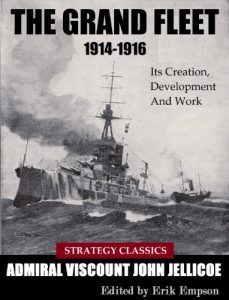*An account of the Battle of Jutland by the man who held Britain's fate in his hands*
This is a blow by blow account of the naval war 1914-1916 written by the Admiral of the Grand Fleet John Jellicoe. It includes his detailed account of the battles of Heligoland Bight, Dogger Bank and Jutland, the sinking of the HMS Hampshire and the death of Lord Kitchener. Jellicoe gives an extensive account of the makeup of the fleet, the disposition of its vessels, and the challenges faced by one of the largest navies the world was ever to see and a mighty foe apparently bent on its destruction.
With an extensive introduction, commentary and annotations by Erik Empson relating to ship classes and armaments, historical context, disputes concerning Jellicoe’s accounts, and the contemporary discussion about this central episode in the first world war. The book includes topics such as early torpedo warfare, range finding, the navy’s early use of planes in combat and submarine warfare. As a reference work it is a essential guide to the ships of the Great War from the might super-dreadnought to the humble patrol boat as well as the commanders and men that fought and died in them.
The book is jam-packed with rare and unique period illustrations, and throughout period photographs of important vessels are supplied, including rare explanatory designs of vessel classes. It will be of great use to archivists, genealogists, family historians because the book is packed with details about the disposition and movements of many craft at different points, as well as many names of captains and the fates of their crew.
Jellicoe's stewardship of the Grand Fleet created much post-war controversy and this book and its challenging introduction shed much light upon the details of the matter. Most of all it will appeal to people who love nice big boats and can't get enough of well-considered political and military history.
This is a blow by blow account of the naval war 1914-1916 written by the Admiral of the Grand Fleet John Jellicoe. It includes his detailed account of the battles of Heligoland Bight, Dogger Bank and Jutland, the sinking of the HMS Hampshire and the death of Lord Kitchener. Jellicoe gives an extensive account of the makeup of the fleet, the disposition of its vessels, and the challenges faced by one of the largest navies the world was ever to see and a mighty foe apparently bent on its destruction.
With an extensive introduction, commentary and annotations by Erik Empson relating to ship classes and armaments, historical context, disputes concerning Jellicoe’s accounts, and the contemporary discussion about this central episode in the first world war. The book includes topics such as early torpedo warfare, range finding, the navy’s early use of planes in combat and submarine warfare. As a reference work it is a essential guide to the ships of the Great War from the might super-dreadnought to the humble patrol boat as well as the commanders and men that fought and died in them.
The book is jam-packed with rare and unique period illustrations, and throughout period photographs of important vessels are supplied, including rare explanatory designs of vessel classes. It will be of great use to archivists, genealogists, family historians because the book is packed with details about the disposition and movements of many craft at different points, as well as many names of captains and the fates of their crew.
Jellicoe's stewardship of the Grand Fleet created much post-war controversy and this book and its challenging introduction shed much light upon the details of the matter. Most of all it will appeal to people who love nice big boats and can't get enough of well-considered political and military history.






